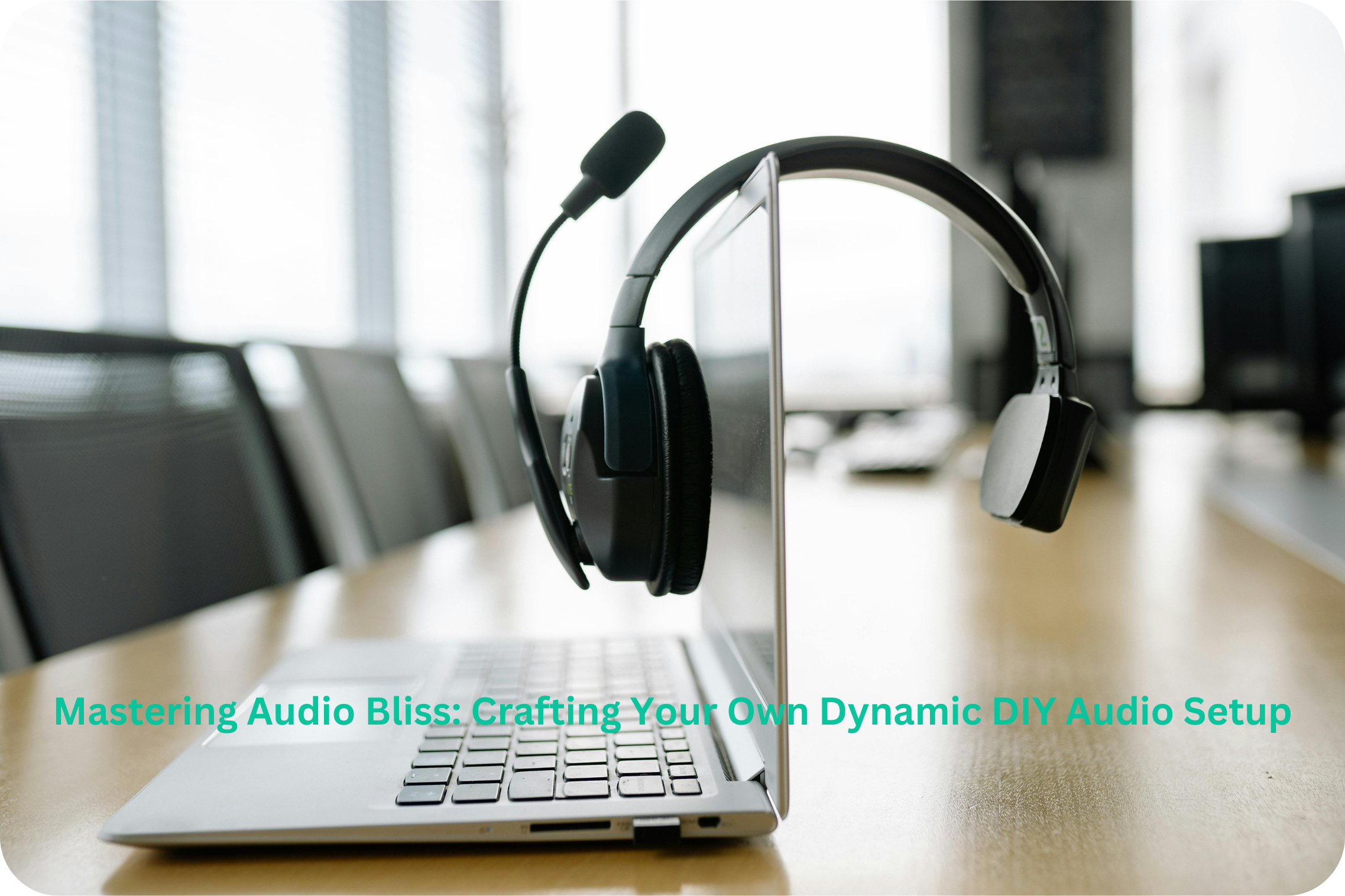Welcome to our blog, where we dive into the realm of DIY audio setups and guide you towards creating your very own harmonious soundscape. Whether you’re a music enthusiast, a podcast creator, or simply someone who appreciates top-notch audio quality, this article is for you. In this informative piece, we’ll explore the fascinating world of DIY audio setups, empowering you with the knowledge and tools needed to build a personalized system that caters to your unique preferences. So, let’s embark on this sonic journey and uncover the secrets to achieving audio bliss!
The Foundation: Understanding DIY Audio Setup Basics
Before we dive into the nitty-gritty details of crafting your own DIY audio setup, it’s essential to grasp the fundamental concepts that lay the groundwork for a remarkable audio experience. Let’s explore the key aspects:
1. Speaker Selection
Choosing the right speakers is crucial for a DIY audio setup. Consider factors such as size, power handling, sensitivity, and frequency response. Whether you prefer bookshelf speakers, floor-standing models, or compact satellites, understanding their specifications will help you make an informed decision.
2. Amplifiers and Receivers
An amplifier or receiver plays a vital role in powering your speakers and enhancing audio signals. Explore different amplifier classes like A, AB, D, and digital options. Consider factors such as power output, connectivity options, and compatibility with your speaker selection.
3. Audio Sources
Identify the audio sources you’ll be using for your setup. Whether it’s a turntable, CD player, streaming device, or computer, ensure compatibility with your selected amplifier and speakers. Pay attention to connection options such as analog, digital, or wireless to achieve seamless integration.
4. Cables and Wiring
Proper wiring and cable selection are often overlooked but significantly impact audio quality. Research different cable types like speaker cables, interconnects, and HDMI cables. Additionally, understand cable lengths, gauge sizes, and terminations to avoid signal loss and interference.
5. Room Acoustics
The acoustic characteristics of your listening space influence the overall sound quality. Experiment with room placement, speaker positioning, and acoustic treatments like diffusers or absorbers to optimize sound reflection, minimize echoes, and create a balanced listening environment.
By familiarizing yourself with these foundational elements, you’ll be well-prepared to embark on your DIY audio setup journey. So, let’s move on to the next section and explore the components in greater detail.
Choosing the Right Speakers for Your DIY Audio Setup
When it comes to crafting your DIY audio setup, selecting the right speakers is paramount to achieving exceptional sound quality. Let’s delve into the factors you should consider:
1. Speaker Types
There are various speaker types available, each with its unique characteristics. Bookshelf speakers are compact and versatile, ideal for smaller spaces. Floor-standing speakers, on the other hand, provide a larger soundstage and deeper bass response. Consider your room size and audio preferences when deciding on the type that suits you best.
2. Size and Form Factor
The size of the speakers can impact their placement and overall aesthetic appeal. Compact bookshelf speakers are suitable for limited spaces, while larger floor-standing models may require more room to breathe. Consider the dimensions and form factor that align with your desired setup and room layout.
3. Power Handling and Sensitivity
Power handling and sensitivity ratings determine how loud and efficient your speakers can be. Power handling is measured in watts and indicates the maximum power a speaker can handle without distortion. Sensitivity, measured in decibels (dB), determines how efficiently the speakers convert power into sound. Higher sensitivity ensures better sound output with less power.
4. Frequency Response
The frequency response range indicates the range of audio frequencies a speaker can reproduce. A wider frequency response allows for more accurate sound reproduction across the entire audible spectrum. Consider the genres of music or content you’ll be primarily listening to and choose speakers with a suitable frequency response range.
5. Listening Tests and Reviews
While specifications are essential, nothing beats listening tests and reviews when making a final decision. Visit local audio stores or attend audio exhibitions to listen to speakers in person. Additionally, read reviews from trusted sources to gather insights from other enthusiasts who have hands-on experience with the speakers you’re considering.
By carefully considering these factors, you can ensure that the speakers you choose are perfectly tailored to your DIY audio setup. In the next section, we’ll explore amplifiers and receivers, another crucial component of your audio system.
Amplifiers and Receivers: Enhancing Your DIY Audio Setup
Once you’ve chosen your speakers, it’s time to select the right amplifier or receiver to power and enhance your DIY audio setup. Let’s explore the key considerations:
1. Amplifier Classes
Amplifiers come in different classes, each with its own characteristics. Class A amplifiers offer high-quality sound but tend to be less efficient and generate more heat. Class AB amplifiers strike a balance between efficiency and sound quality. Class D amplifiers are highly efficient and suitable for compact setups. Consider your power requirements and desired sound characteristics when choosing an amplifier class.
2. Power Output
The power output of an amplifier determines how loud and dynamic your speakers can perform. It is typically measured in watts per channel. Consider the power requirements of your speakers and your listening preferences to ensure that the amplifier can deliver adequate power without distortion.
3. Connectivity Options
Consider the connectivity options offered by the amplifier or receiver. Analog inputs allow you to connect devices like turntables or CD players directly, while digital inputs cater to modern sources such as streaming devices or computers. Additionally, check for wireless connectivity options like Bluetooth or Wi-Fi if you prefer a cable-free setup.
4. Compatibility with Speakers
Ensure that the amplifier or receiver is compatible with your selected speakers in terms of impedance and power requirements. Mismatched impedance can lead to distortion and poor sound quality. Check the specifications of both the amplifier and speakers to ensure a harmonious match.
5. Additional Features
Explore additional features that the amplifier or receiver may offer. This could include tone controls, built-in equalizers, room correction technology, or even multi-room audio capabilities. Consider your specific needs and preferences to determine which features are essential for your setup.
By carefully considering these factors, you can select an amplifier or receiver that complements your speakers and elevates your DIY audio setup to new heights. In the next section, we’ll explore the various audio sources you can integrate into your system.
Exploring Audio Sources for Your DIY Audio Setup
When building your DIY audio setup, it’s essential to consider the audio sources that will be the heart of your system. Let’s explore the different options available:
1. Turntables
If you’re a vinyl enthusiast, a turntable is a must-have audio source for your DIY setup. Look for a turntable with features like adjustable tonearm, anti-skate mechanism, and a high-quality cartridge to ensure accurate playback of your vinyl collection.
2. CD Players
CD players are a reliable source for high-quality audio. Look for a CD player with advanced digital-to-analog converters (DACs) and a solid build to ensure accurate and detailed sound reproduction from your CDs.
3. Streaming Devices
Streaming devices have become increasingly popular, allowing you to access a vast library of music from various streaming platforms. Look for streaming devices that offer high-resolution audio support and seamless integration with your DIY audio setup.
4. Computers and Laptops
Computers and laptops can serve as versatile audio sources, especially when paired with a high-quality DAC. You can play digital music files, stream online content, or use software for music production. Consider using lossless audio formats for the best audio quality.
5. Mobile Devices
Mobile devices such as smartphones and tablets can be convenient sources for on-the-go listening. Ensure that your DIY audio setup supports wireless connectivity options like Bluetooth or Wi-Fi, allowing you to easily stream music from your mobile devices.
6. Other Audio Sources
Consider other audio sources that you may want to integrate into your setup, such as cassette decks, reel-to-reel tape machines, or even radio tuners. These sources can add a unique touch to your audio experience, catering to specific preferences or nostalgic vibes.
By exploring these various audio sources, you can choose the ones that align with your music preferences and create a versatile DIY audio setup that covers all your audio needs. In the next section, we’ll delve into the importance of cables and wiring for optimal audio performance.
The Importance of Cables and Wiring in Your DIY Audio Setup
While often overlooked, cables and wiring play a crucial role in the overall performance of your DIY audio setup. Let’s explore why they are essential and what you should consider:
1. Speaker Cables
Speaker cables carry the audio signal from the amplifier to the speakers. Opt for cables with suitable gauge sizes, typically determined by the length of the cable and power requirements of your speakers. Thicker cables with low resistance can help minimize signal loss and maintain optimal audio quality.
2. Interconnect Cables
Interconnect cables connect audio sources to amplifiers or receivers. Look for cables with good shielding and low capacitance to minimize interference and maintain signal integrity. Consider the type of connectors (such as RCA or XLR) based on your specific setup requirements.
3. Digital Cables
Digital cables, such as HDMI or optical cables, transmit digital audio signals between devices. For optimal performance, choose cables that are capable of handling high bandwidth and support the necessary protocols for your audio sources. Consider cable length limitations for longer distances.
4. Cable Lengths and Placement
Ensure that your cables are of appropriate lengths for your setup. Excessively long cables can introduce signal degradation, while very short cables may limit placement flexibility. Proper cable management and organization can help reduce clutter and minimize the risk of cable damage or interference.
5. Cable Termination
Pay attention to the termination of your cables. High-quality connectors and terminations ensure secure connections and minimize the risk of signal loss or distortion. Consider connectors made of materials like gold or silver, which offer good conductivity and corrosion resistance.
6. Cable Upgrades and Auditioning
While the impact of cable upgrades can be subjective, some enthusiasts believe in the potential for improved audio quality. If you’re considering cable upgrades, auditioning different cables in your setup can help you determine if there are noticeable differences in sound reproduction that align with your preferences.
By giving due consideration to cables and wiring, you can optimize the signal flow and minimize potential audio degradation in your DIY audio setup. In the next section, we’ll explore the significance of room acoustics and how to create an ideal listening environment.
Congratulations on reaching the end of our comprehensive guide to DIY audio setups! We hope this article has provided you with valuable insights and knowledge to embark on your own audio adventure. From understanding the basics of speaker selection to exploring amplifiers, audio sources, cables, and room acoustics, you now have a solid foundation to create a personalized and exceptional audio setup.
Remember, building a DIY audio setup is a journey that involves careful consideration, experimentation, and fine-tuning. Take the time to research and select components that align with your preferences and budget. Don’t hesitate to audition different options and seek advice from audio enthusiasts or professionals if needed.
Lastly, enjoy the process of crafting your audio haven and immersing yourself in the incredible world of music, podcasts, or any content that brings you joy. Your DIY audio setup has the potential to elevate your listening experience to new heights and provide countless hours of pure audio bliss.
Thank you for joining us on this sonic journey. Happy crafting and happy listening!

